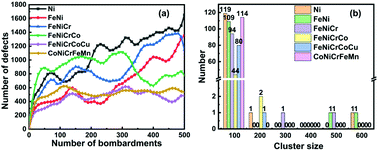Atomistic insights of a chemical complexity effect on the irradiation resistance of high entropy alloys†
Abstract
High irradiation tolerance is a key feature required for designing structural materials for next-generation nuclear reactors, for which high entropy alloys (HEAs) and equiatomic multicomponent single-phase alloys are good candidates. In this paper, the effect of chemical complexity on irradiation resistance is investigated using molecular dynamics simulations. Taking the classical Cantor alloy CoCrFeMnNi as a paradigm, we have studied the number of defects, the size of defect clusters and dislocation of six FCC materials, pure Ni, FeNi, CrFeNi, CoCrFeNi, CoCrCuFeNi and CoCrFeMnNi, under consecutive bombardment. The fewest defects can be observed in two HEAs, and so can the size of defect clusters. Multicomponent alloys also show better performance in terms of irradiation resistance than pure Ni. The reason can be attributed to the complexity of high entropy alloys and multicomponent alloys, which leads to lattice distortion and hysteresis diffusion effects. The longest and shortest dislocation lengths are observed in CoCrCuFeNi and CoCrFeMnNi. A larger number of stacking faults is observed in CoCrCuFeNi. The fewer defects and dislocations of CoCrFeMnNi indicate its promising applications in nuclear structural materials.



 Please wait while we load your content...
Please wait while we load your content...